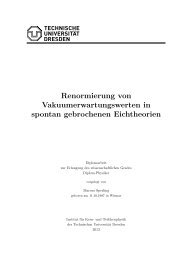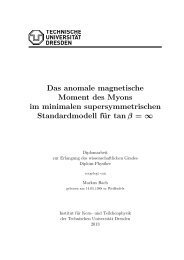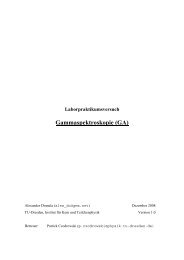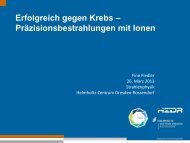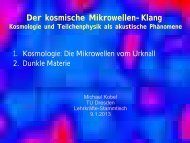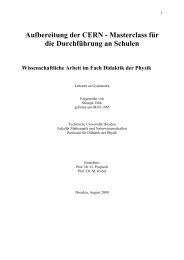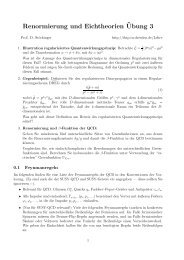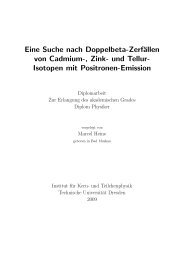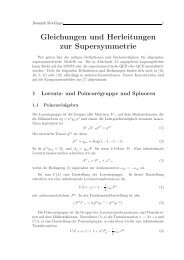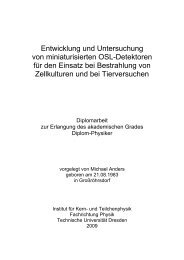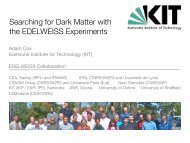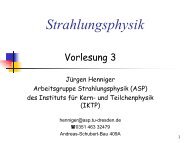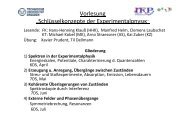a design study for a cobra upgrade to - Institut für Kern- und ...
a design study for a cobra upgrade to - Institut für Kern- und ...
a design study for a cobra upgrade to - Institut für Kern- und ...
You also want an ePaper? Increase the reach of your titles
YUMPU automatically turns print PDFs into web optimized ePapers that Google loves.
38 4 Scintillation detec<strong>to</strong>rs<br />
group of radioactive nuclides in scintilla<strong>to</strong>rs are anthropogenic nuclides<br />
like 60 Co and 137 Cs. Some scintilla<strong>to</strong>rs consist of elements containing<br />
radioactive iso<strong>to</strong>pes like listed below in 4.1.<br />
Scintilla<strong>to</strong>r Radioiso<strong>to</strong>pe<br />
CdWO4 (CWO) 113Cd Gd2SiO5 (GSO) 152Gd LaCl3 and LaBr3<br />
138La Lu2SiO5 and LuI3<br />
176Lu PbWO4 (PWO) 210Pb Table 4.1: List of some scintillation materials and contained radioiso<strong>to</strong>pes<br />
[35].<br />
Scintilla<strong>to</strong>rs based on Pb (except ancient Pb, which is expensive), La<br />
and especially Lu can have a radioactivity of 10 and even a few 10000<br />
Bq/kg <strong>for</strong> Lu [35, 36]. The most radiopure crystal scintilla<strong>to</strong>rs like<br />
ZnWO4, CdWO4 and low backgro<strong>und</strong> optimised CaF2:Eu, NaI:Tl and<br />
CsI:Tl have low contamination of 0.01-0.1 mBq/kg [35]. However, it<br />
is possible <strong>to</strong> produce crystals from depleted or enriched iso<strong>to</strong>pes, but<br />
this will increase the price significantly.<br />
The other aspects of the scintilla<strong>to</strong>r, like available size, light yield, price<br />
and whether it is hygroscopic reduce the list of possible scintilla<strong>to</strong>rs<br />
further. Scintilla<strong>to</strong>rs, like ZnS:Ag, ZnWO4, CaF2:Eu are not available<br />
in adequate size. CaI2 has a high light yield but a low density and it is<br />
highly hygroscopic. Y3Al5O12 (YAG) has a slightly higher density but<br />
a low light yield. The same arguments apply <strong>for</strong> BaF2 and CaF2.<br />
From these huge spectrum of available scintilla<strong>to</strong>rs especially NaI, CsI,<br />
BGO and CWO are described more closely and their main properties<br />
are listed in table 4.2. They are common scintilla<strong>to</strong>rs, can be obtained<br />
in adequate size, are less expensive than other scintilla<strong>to</strong>rs, have high<br />
density and Z and can be produced with low radioactive contamination.<br />
NaI:Tl is one of the most used scintilla<strong>to</strong>rs. It can be produced in large<br />
dimensions and has a relatively high density and a<strong>to</strong>mic number. Its<br />
emission spectrum matches good with common bialkali pho<strong>to</strong> multiplier<br />
tubes (PMTs). In this range of wavelength (aro<strong>und</strong> 400 nm) NaI:Tl<br />
has the highest light yield of all scintilla<strong>to</strong>rs. High-purity NaI activated<br />
by 10 −3 mole fraction of thallium is a hygroscopic crystal that must be<br />
protected from moisture in the air with an air tight enclosure. The crys-



